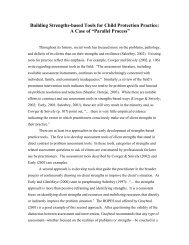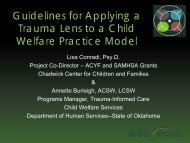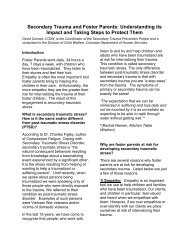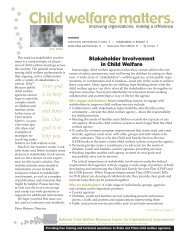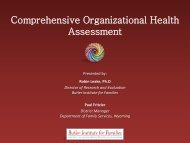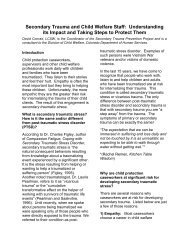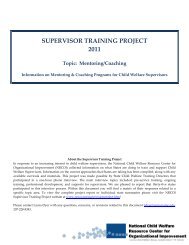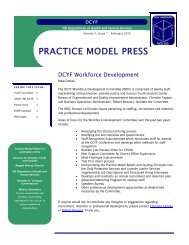Building a Model and Framework for Child Welfare Supervision
Building a Model and Framework for Child Welfare Supervision
Building a Model and Framework for Child Welfare Supervision
You also want an ePaper? Increase the reach of your titles
YUMPU automatically turns print PDFs into web optimized ePapers that Google loves.
Element 4<br />
M<strong>and</strong>ate explicit, manageable st<strong>and</strong>ards <strong>for</strong> caseload size<br />
<strong>and</strong> <strong>for</strong> supervisor-supervisee ratios.<br />
When frontline practitioners’ caseloads are too high, they are not only unmanageable <strong>for</strong><br />
practitioners. Supervisors also cannot adequately monitor their supervisees’ case activities <strong>and</strong><br />
progress <strong>and</strong> thus the desired quality of services <strong>and</strong> engagement with children, youth <strong>and</strong> families<br />
may not be achieved. In order to assure that child welfare supervisors have time to develop <strong>and</strong><br />
maintain a professional relationship with their supervisees, work one-on-one in a planful way with<br />
frontline practitioners, <strong>and</strong> carry out their responsibilities <strong>for</strong> accountability to the agency <strong>and</strong> to the<br />
community, a model <strong>for</strong> child welfare supervision must also provide <strong>for</strong> explicit manageable<br />
supervisor-supervisee ratios (Jacquet et al. 2007; Juby & Scannapieco 2007; Robison 2006;<br />
Weaver, et al. 2007).<br />
Supervisors cannot be sufficiently familiar with the cases assigned to their unit to adequately<br />
monitor their supervisees’ cases when their supervisees’ caseloads are unreasonably high. And<br />
when supervisors are assigned an unmanageable number of supervisees, they can neither provide<br />
regular, individualized supervisory attention to each supervisee nor adequately monitor their<br />
supervisees’ cases.<br />
Both the <strong>Child</strong> <strong>Welfare</strong> League of America (1995, 1999) <strong>and</strong> the Council on Accreditation (2006)<br />
provide guidelines <strong>and</strong> st<strong>and</strong>ards <strong>for</strong> child welfare frontline practitioner caseload size <strong>and</strong><br />
supervisor-supervisee ratios.<br />
Element 5<br />
Define expectations with regard to the frequency <strong>and</strong> <strong>for</strong>mat<br />
<strong>for</strong> supervision of frontline practitioners.<br />
To assure individualized, uninterrupted supervisor interaction with each supervisee as well as<br />
regular opportunities <strong>for</strong> supervisees to learn from their peers <strong>and</strong> receive <strong>and</strong> give mutual aid, a<br />
model <strong>for</strong> child welfare supervision should define expectations regarding the frequency <strong>and</strong> <strong>for</strong>mat<br />
of frontline practitioner supervision. Supervisors should be held accountable to adhere to the<br />
defined expectations of frequency <strong>and</strong> <strong>for</strong>mat <strong>for</strong> meeting with supervisees <strong>and</strong> be encouraged to<br />
identify <strong>and</strong> address obstacles to accomplishing this task.<br />
Both regularly scheduled individual <strong>and</strong> group<br />
supervision/case reviews should be incorporated in the model<br />
of supervision <strong>for</strong> frontline practitioners. Peer group<br />
supervision provides efficient, regular access to multiple<br />
perspectives <strong>for</strong> learning, the development of group cohesion<br />
<strong>and</strong> a sense of belonging among practitioners, an appreciation<br />
that these are “`our’ problems rather than `my’ problems’”<br />
(Kadushin & Harkness 2002: 391-399), <strong>and</strong> a decrease in<br />
practitioner burnout (Marks & Hixon 1986).<br />
Mentors can share their<br />
experiences <strong>and</strong> relate them to<br />
what someone is going through.<br />
It’s helpful to relate to someone<br />
else’s experiences. Mentors can<br />
take their experiences <strong>and</strong><br />
knowledge <strong>and</strong> help others<br />
individualize it. – Supervisor<br />
20




